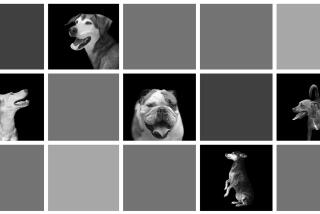A greyhound group’s challenge: ‘How do you turn a racing machine into a pet?’
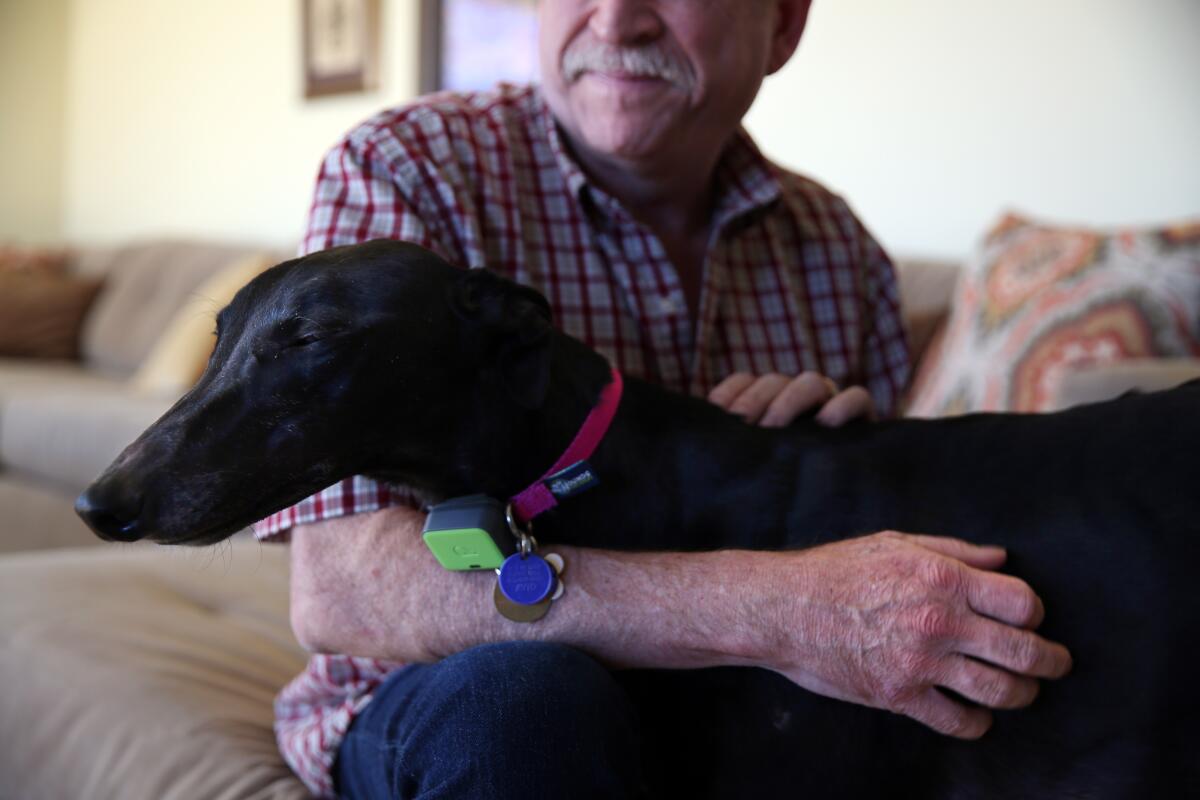
- Share via
Greyhounds are the fastest dogs on the planet. With a small head and a lithe, aerodynamically shaped body as well as strong paws and a proportionately bigger heart than that of any other dog breed, greyhounds can run at speeds of up to 45 mph. They’ve been bred for speed, intelligence and agility since ancient times, first for hunting and later for sport racing.
Racing greyhounds usually retire between the ages of 2 and 5. Some that race in Tijuana are lucky enough to have a shot at a second type of life, to abandon the very thing they’ve been trained to do. It takes just a week or so in the care of devoted volunteers for the dogs to become loving pets. It’s an astonishing transformation, considering these former racers have never lived with a family; seen children, cats, or other breeds of dogs; or been inside a house.
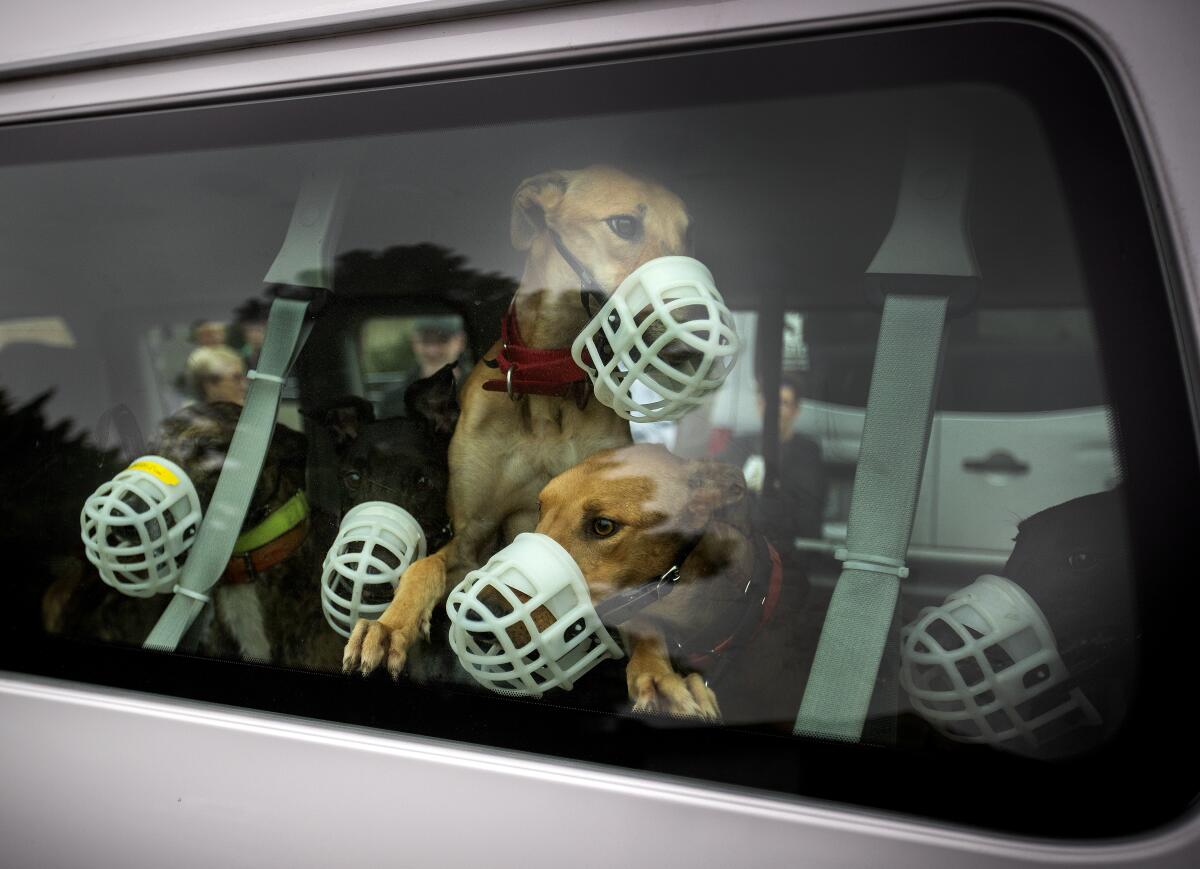
“How do you turn a racing machine into a pet?” asks Cathy Kiburtz, president of GreySave, an L.A. County-based greyhound adoption group. “It starts right now.” Kiburtz and 35 volunteers wait outside a ranch-style house in Chino at 9:30 a.m. on a recent Saturday. A white van pulls up. In the back are eight greyhounds from the Agua Caliente Racetrack in Tijuana. Before retiring, these dogs raced two or three times a week, resting alone in their crates and exercising as a group between competitions.
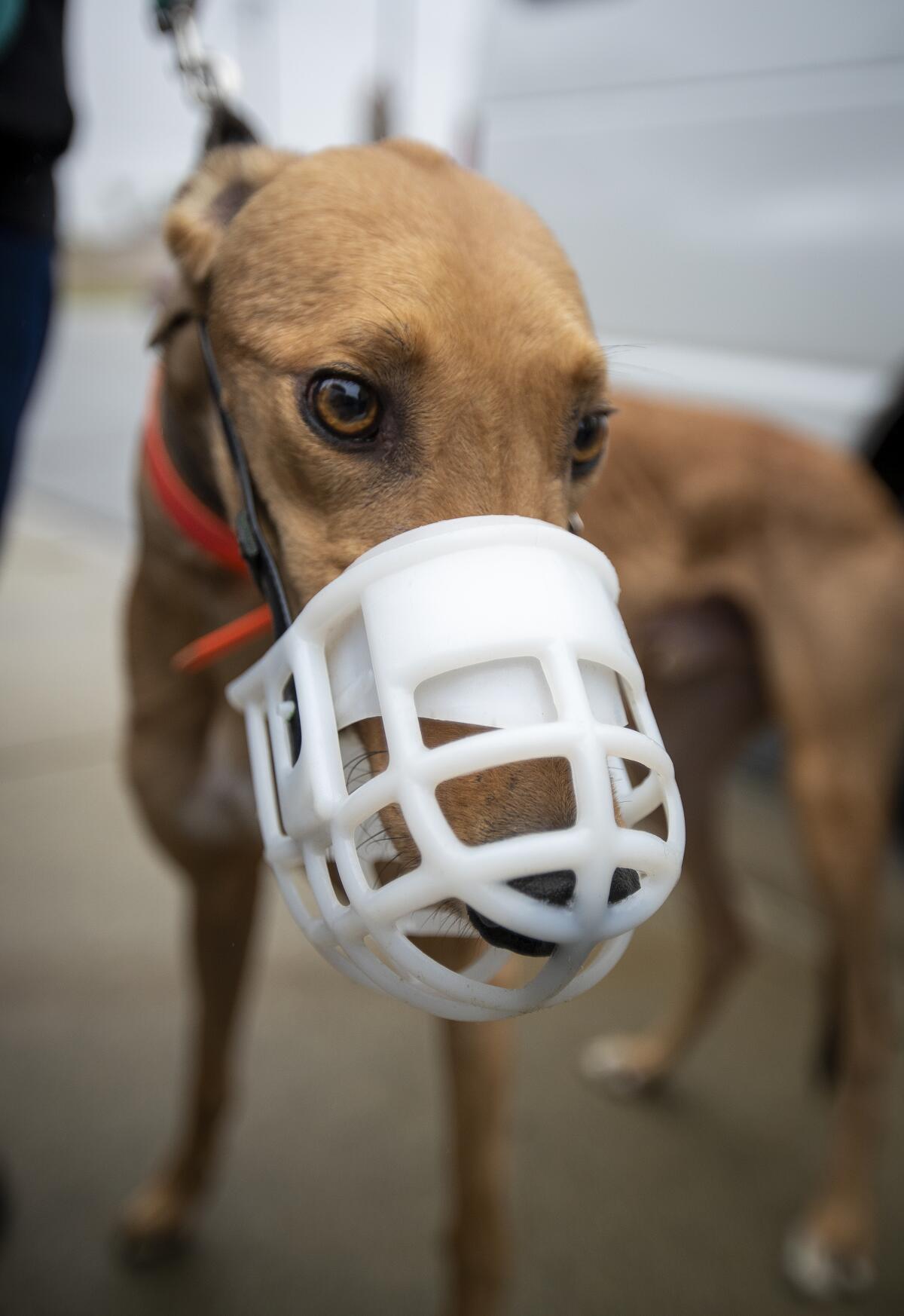
After the 100-mile trip, they stare out the van windows, some bewildered, some excited, plastic muzzles over their long delicate snouts tap-tapping on the glass. Greyhounds aren’t just gray either; they can be black, bluish gray, light red or brindled in different shades of red or blue. They typically live 10 to 13 years, stand as tall as 30 inches and weigh 60 to 70 pounds, according to the American Kennel Club.
Volunteers leash the dogs, gently unload them from the van and pair each with a designated handler. The handlers ready doggy-poop bags and lead their charges on a walk through the neighborhood. “We introduce the dogs to sidewalks, lawns and traffic noise — things they’ve never experienced — and hope to get a fecal sample to test for hookworm,” Kiburtz says. “It’s step one in what we call their homecoming day.”
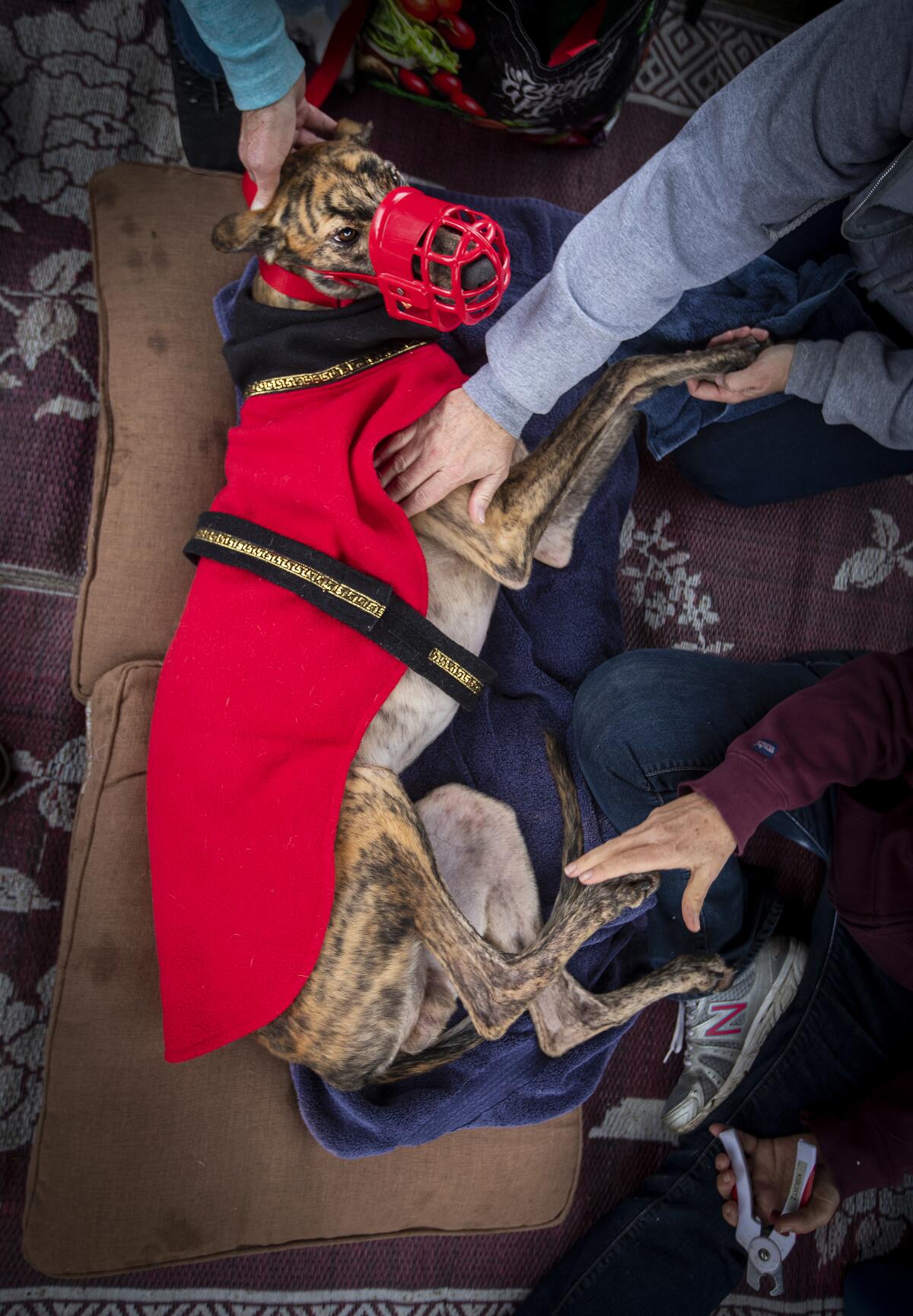
GreySave is one of more than 100 nonprofit greyhound adoption organizations in the U.S.. “Together, they find homes for more than a thousand retired racing greyhounds a year,” says Jim Gartland, executive director of the National Greyhound Assn., the official registry of the breed. “That’s a big step from the old days of greyhound racing, before my time.”
In the 1980s and early 1990s, reports of euthanizing retired racing dogs and other bad press led to the establishment of greyhound adoption groups. “Once the public realized that retired racers make great pets, they couldn’t get enough of them,” Gartland says.
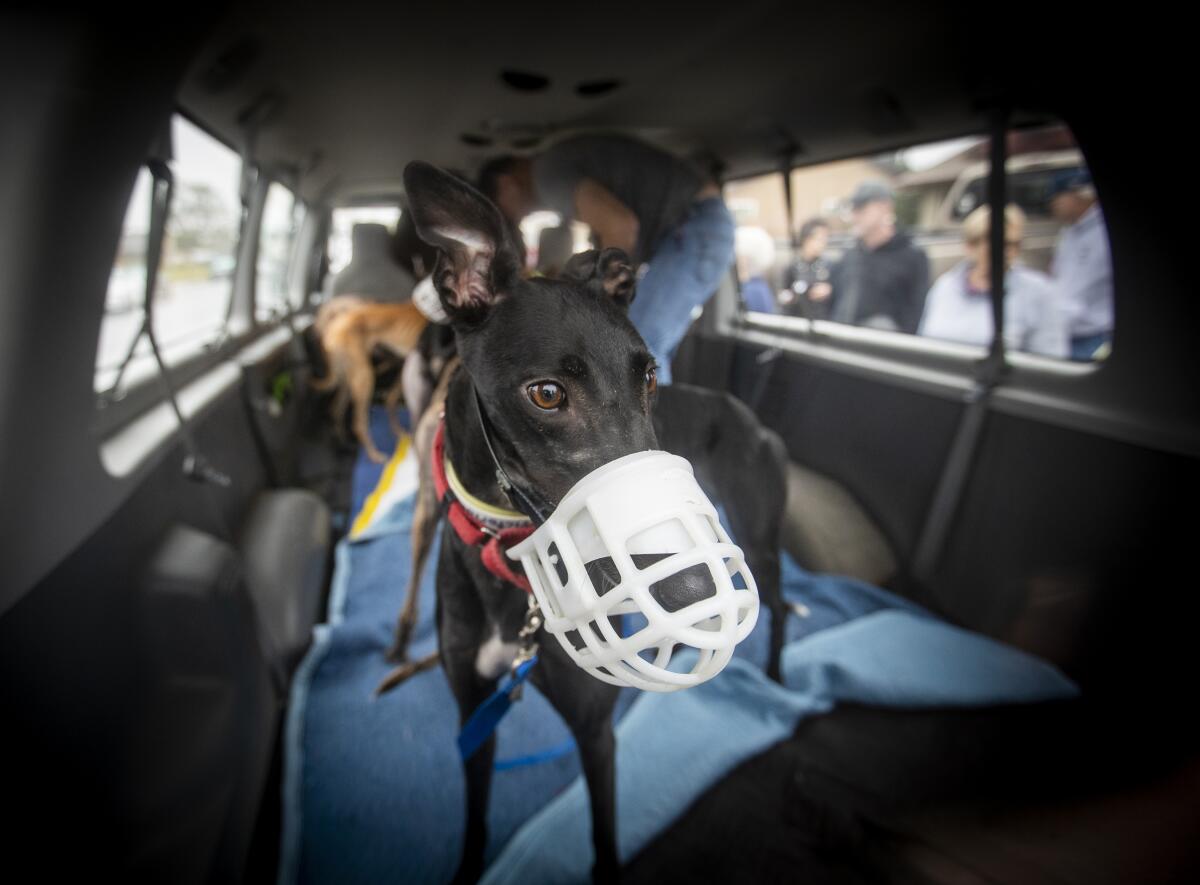
One hard and fast rule: Never let a racing greyhound off its leash. As sight hounds, they instinctively chase anything they perceive as prey, even a leaf or plastic bag fluttering in the wind. Unlike scent hounds, such as beagles, they lack an instinct to follow a scent to lead them back home. Greyhounds are allowed to run free only in fenced-in backyards.
A noble lineage
Admiration for greyhounds goes back centuries. Art and coins from ancient Greece depict short-haired hounds resembling modern greyhounds. Mummified greyhounds have been found in the tombs of Egyptian kings. The Romans used greyhound ancestors for sport, sending dogs chasing after a live hare. When the Romans conquered Britain, they brought greyhounds and the sport of “coursing” with them.
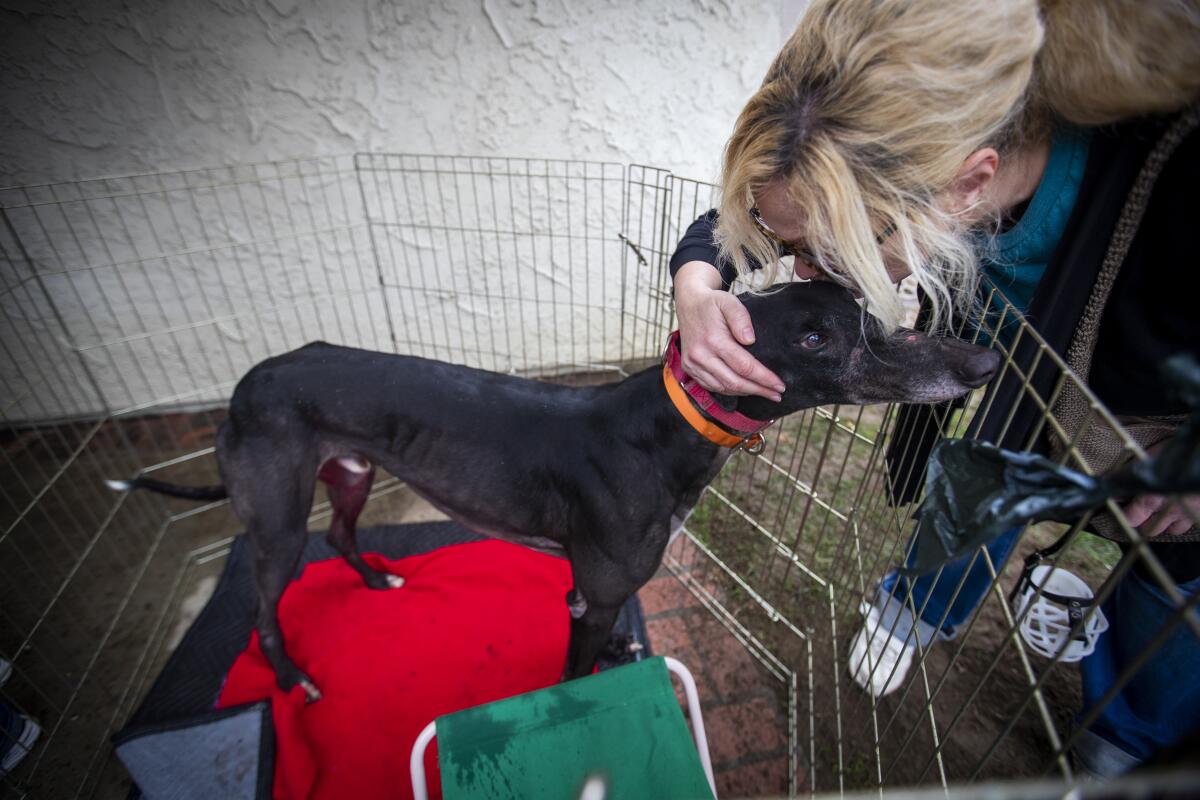
British coursing evolved into track racing during the 19th century. Around the same time, large numbers of greyhounds were exported to the U.S. from England and Ireland, not to course or race, but to combat an infestation of crop-eating jackrabbits on Midwestern farms. After the invention of the mechanical lure in 1912, the first U.S. greyhound racetrack opened in Emeryville, Calif., seven years later. Soon the sport of greyhound racing spread throughout the country.
By 1992, greyhound racing was one of the most popular American spectator sports, with 50-plus racetracks drawing 3.5 million fans who wagered nearly $3.5 billion. The sport has steadily declined in the U.S. since then. Pressure from animal-rights groups led many states, including California, to outlaw greyhound racing. In addition, its popularity became overshadowed by other forms of gambling, such as casinos on tribal lands, riverboat gambling and state-run lotteries.
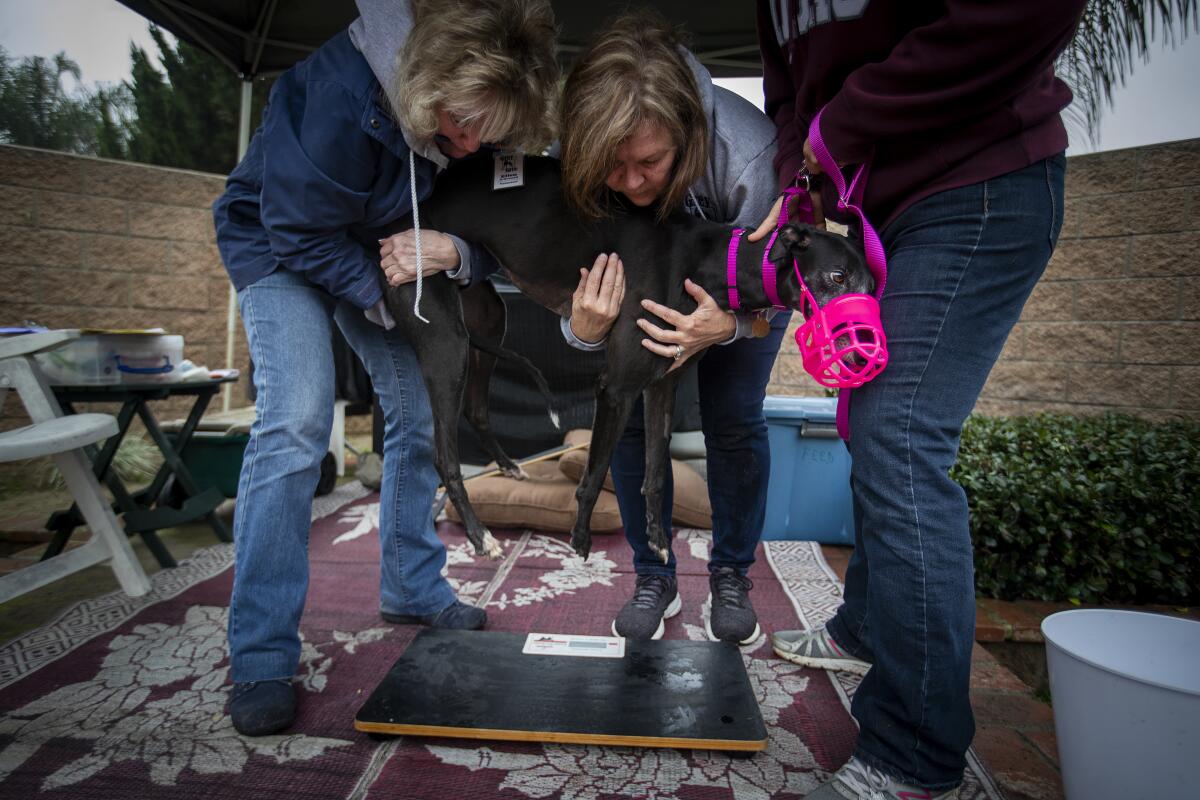
Today, there are only 16 greyhound racetracks left in the U.S., including six in Florida, which will shut down by the end of 2020. “After the Florida tracks close, I expect there may be as many as 500 greyhounds needing homes,” Gartland says. “But they will be taken in by adoption groups on the East Coast and in the Midwest. Few will make it to California.”
The Tijuana racetrack still races greyhounds 365 days a year and has no plan to stop. GreySave is one of only two adoption groups approved by the greyhound association to bring retired dogs from the Mexican site to the U.S. and put them up for adoption.
“When we started in 1998, the track wouldn’t let us come in, but we’ve had a good working relationship with them for years now,” says Joyce McRorie, president of FastFriends, a greyhound-adoption group based in La Habra Heights.
Like FastFriends, GreySave had to develop a relationship with the track and a transportation process. “Our problem was getting the greyhounds across the border,” Kiburtz says. “At first, we transported them in crates in a windowless van, like a UPS truck, but border guards would get suspicious. Now we use an 11-passenger van with the seats taken out and the dogs loose in back. The guards see a bunch of needle-nosed dogs staring out the windows at them, wagging their tails, and can’t help but smile.”
Retraining with love
In Chino, after walking the dogs through the neighborhood, handlers sit with them in portable pens set up in the backyard of the homecoming house. “The handlers stay close to their dogs through the check-in steps, giving them lots of love and attention,” Kiburtz says. “By the end of the day, they’ll have a sense of their dog’s personality. This helps us choose the best foster or foster-to-adopt home for them.”
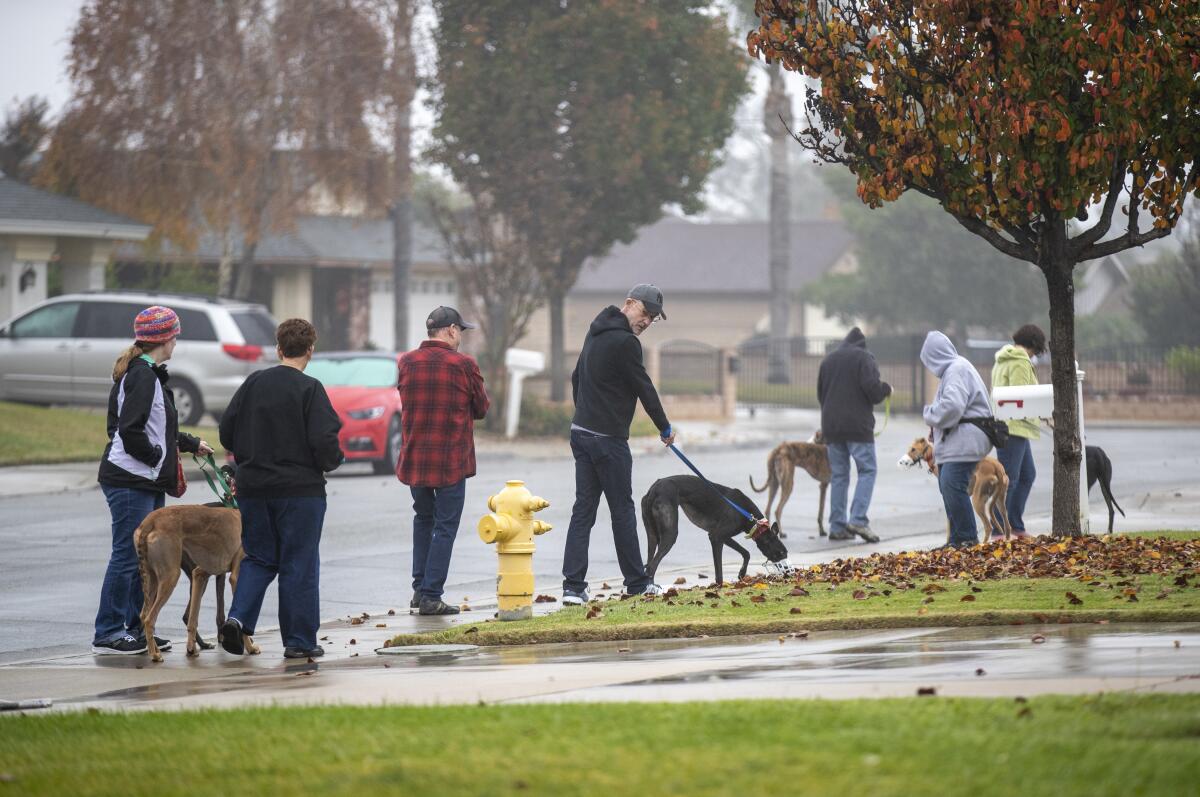
Volunteers, all of whom have fostered and/or adopted multiple greyhounds, staff a variety of check-in stations. At one, dogs are weighed, inspected for ticks and verified by IDs tattooed inside their ears. At another, dogs get their first warm bath. Once they’re clean, dogs take turns settling onto a soft doggy bed in what Kiburtz calls the “spa tent.” Here a volunteer clips the dog’s nails while another cleans its ears and a third massages its body. “These dogs have worked hard in their lives,” she says. “They deserve to be pampered.”
A team of six, including a Kaiser Permanente doctor, staff the medical station. They draw dogs’ blood, check them for injuries, update their inoculations and insert ID microchips under their skin in case they get lost and end up in a shelter.
“Today’s a good day,” Kiburtz says. “We took in our 1,479th dog, and only one had a medical problem.” A volunteer drives a greyhound with two suspected broken toes to a vet, where its foot is X-rayed and wrapped in a splint.
“People pay $300 to adopt a greyhound from us,” Kiburtz says. “They don’t realize that we spend an average of $800 per dog before then, on things like spaying and neutering, teeth cleaning and, if necessary, rabies booster shots. And that’s for dogs without serious medical issues.”
After lunch and a rest — for greyhounds and volunteers — it’s time to assign the dogs to foster or foster-to-adopt homes. First, each must pass a test. “Greyhounds are sight hounds as opposed to scent hounds, like beagles,” Kiburtz says. “They’re bred to chase a lure that is often a fluffy stuffed animal .... We need to verify that if they see a small dog or a cat, they won’t make a lunge for it.”
A handler slips a muzzle on Vicky, at 2 the youngest greyhound retiree in the pack. He walks her over to a grizzled Chihuahua-terrier mix named Audie, a star in the “small-dog test” performed at every homecoming. Vicky excitedly sniffs Audie all over, her tail waving like the world’s fastest metronome. With a rumbling growl you’d never expect from a dog that little, Audie persuades Vicky to back off.
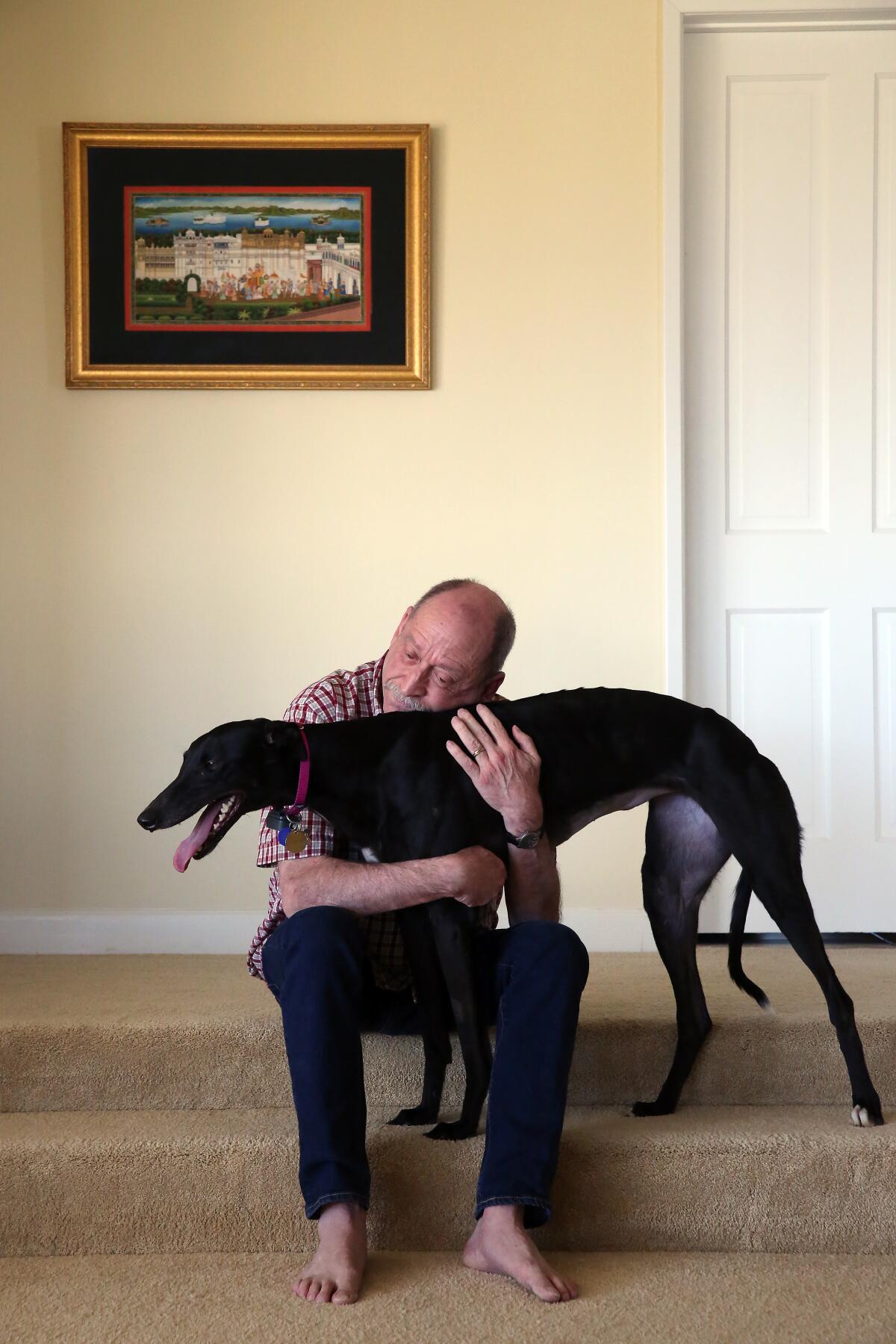
Tim Lignoul, a retired attorney from Encino who has fostered 31 greyhounds, is here today to select a foster-to-adopt dog as a companion for his elderly greyhound at home. “We lost Heidi’s greyhound buddy to cancer last month, and she’s been lonely,” he says. He chooses Vicky.
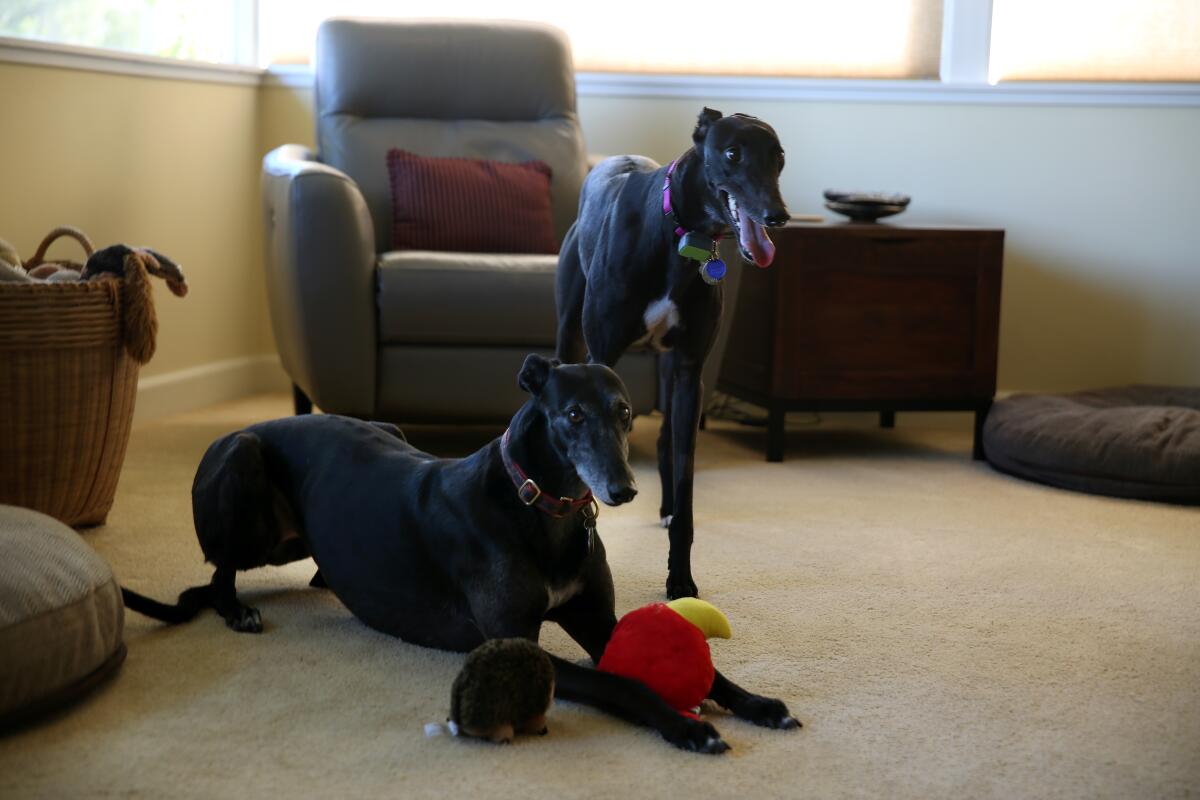
“We say about greyhounds: Two is easier than one,” Kiburtz says. “Retired greyhounds have been around other greyhounds their entire lives. Most of them crave canine company.” (The day after the homecoming Lignoul reported to Kiburtz that Vicky and Heidi had become fast friends.)
A black 5-year-old named Raven is the oldest retired greyhound in the bunch. There are nicks and scratches on his snout, but he wags his tail high in the air, a sign of confidence. “He raced to the maximum age for a good reason,” says Kiburtz, glancing at a printout of the dog’s racing record. “Out of 377 races, Raven came in first 51 times and second 59 times. He made someone a lot of money.”
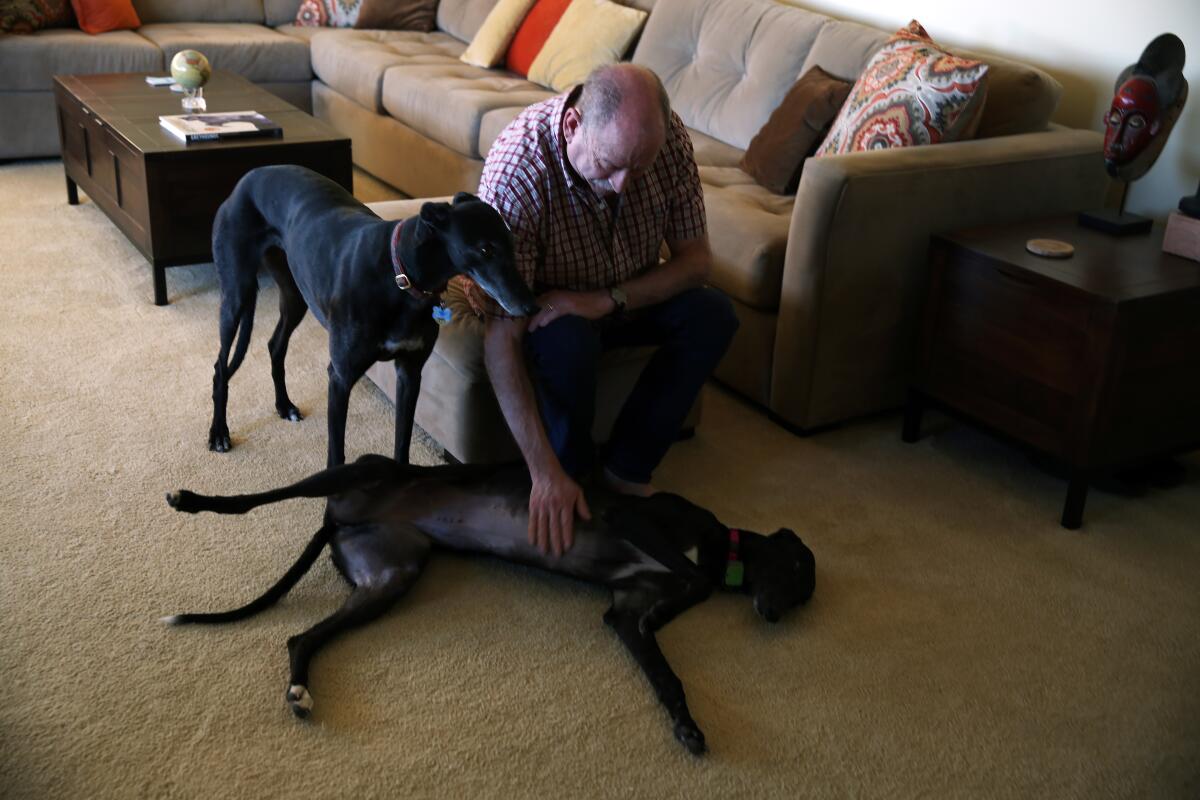
Raven passes the “cat test” with a no-nonsense black-and-white cat named Orion. Katie Fornadel, who has fostered 70 greyhounds since 2009, takes Raven home to Ventura. (The next day, however, Fornadel texted Kiburtz that Raven was having a bit of trouble. “Raven is playing with Katie’s two dogs, but he’s showing way too much interest in her three cats,” said Kiburtz. “If he doesn’t adjust in a couple of days, we’ll move him to another foster home.”)
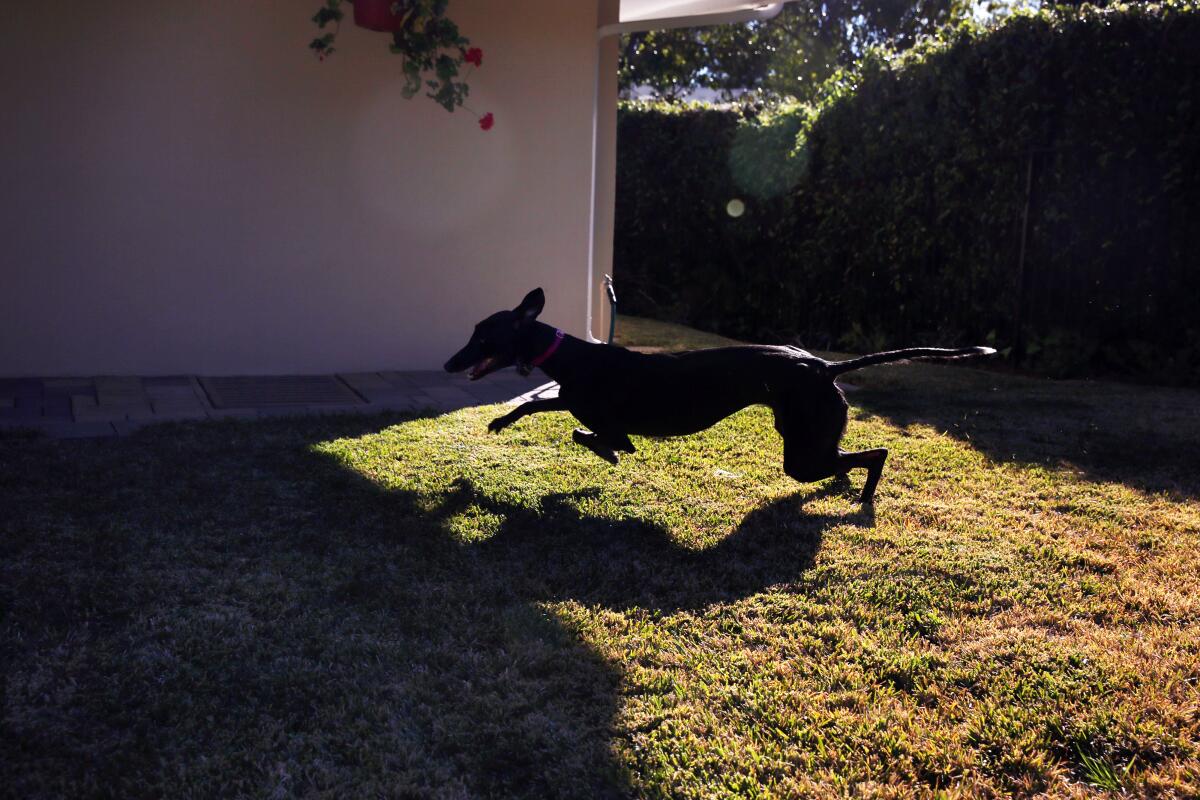
By 3 p.m. at the homecoming house, the pens have been folded up, the backyard cleared and the bathtub stored away for the next greyhound homecoming in a month or so. The volunteers say their goodbyes. Those taking dogs bring along goody bags stuffed with dog-food samples and anti-tick-and-flea remedies, along with a greyhound blanket and coat and assorted doggy toys. “You won’t believe how fast a former racing dog can turn into a couch potato,” says Kiburtz.
With so many tracks closing and breeders therefore closing kennels, Kiburtz foresees a time when it will become harder to find retired racing greyhounds to adopt in the U.S. “With our connection to the Tijuana racetrack, we may be one of the only adoption groups to get dogs,” she says. “It’s too bad, because retired racing greyhounds make great pets. There’s almost something magical about them. We call them ‘Velcro dogs.’ Once they come home with you, they stick to your side.”
Is greyhound adoption for you?
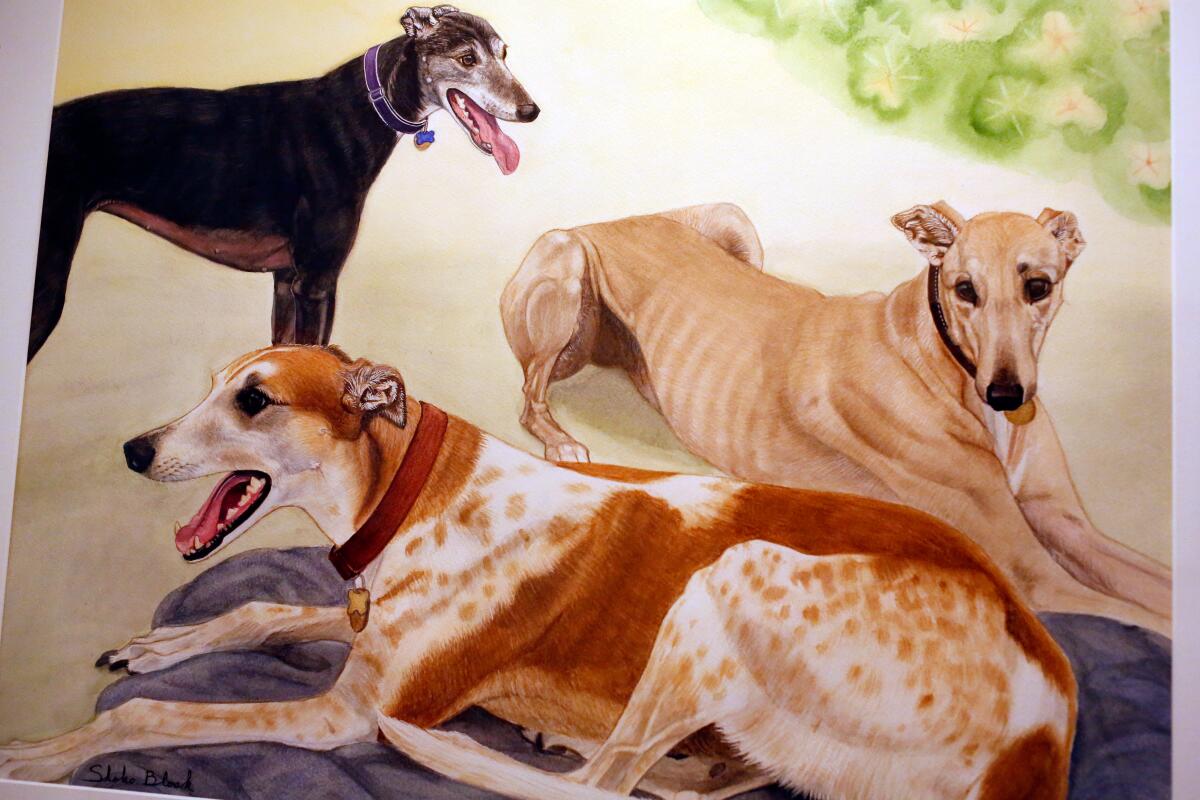
Before you think about adopting a greyhound, here are things to consider:
The upside
- Greyhounds soak up affection and love to play.
- They’re smart and learn quickly, including housebreaking.
- Greyhounds are generally docile and people-friendly; some make good therapy dogs.
- They don’t bark much, and smell and shed less than other dogs.
- They sleep more than 18 hours a day (which works fine if you bring your dog to the office).
The downside
- Greyhounds are miserable if left alone for long periods.
- Dogs must always be on a leash when outdoors, unless you have a yard with a 5-foot fence and a locked gate. If they see something to chase, they may start running and get lost.
- Bred for speed, greyhounds lack an undercoat of fur and have scant body fat. They easily can get scratched, cold, or sun burned.
- Greyhounds are not the best pet for families with young children. “[K]ids under 7 may not be responsible enough to keep the door closed,” says Cathy Kiburtz of GreySave. “Greyhounds are trained to start running when a door opens. We have a saying, ‘Door open, dog gone.’ ”
Tips for greyhounds owners
- Give your former racing greyhound lots of love and attention.
- Praise the dog and give it doggy treats when it’s housebroken.
- Always walk the dog on the same route. This increases the possibility that if your dog gets off leash, it may be able to find its way home.
Where to adopt greyhounds
GreySave (866) 473-9728, GreySave.org
FastFriends Greyhound Adoption of California, (800) 298-5743, FastFriends.org
More to Read
Sign up for The Wild
We’ll help you find the best places to hike, bike and run, as well as the perfect silent spots for meditation and yoga.
You may occasionally receive promotional content from the Los Angeles Times.


